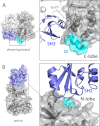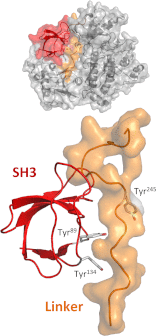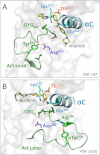Structure and dynamic regulation of Abl kinases
- PMID: 23316053
- PMCID: PMC3581414
- DOI: 10.1074/jbc.R112.438382
Structure and dynamic regulation of Abl kinases
Abstract
The c-abl proto-oncogene encodes a unique protein-tyrosine kinase (Abl) distinct from c-Src, c-Fes, and other cytoplasmic tyrosine kinases. In normal cells, Abl plays prominent roles in cellular responses to genotoxic stress as well as in the regulation of the actin cytoskeleton. Abl is also well known in the context of Bcr-Abl, the oncogenic fusion protein characteristic of chronic myelogenous leukemia. Selective inhibitors of Bcr-Abl, of which imatinib is the prototype, have had a tremendous impact on clinical outcomes in chronic myelogenous leukemia and revolutionized the field of targeted cancer therapy. In this minireview, we focus on the structural organization and dynamics of Abl kinases and how these features influence inhibitor sensitivity.
Figures




Similar articles
-
Mechanisms of resistance to imatinib mesylate in Bcr-Abl-positive leukemias.Curr Opin Oncol. 2002 Nov;14(6):616-20. doi: 10.1097/00001622-200211000-00005. Curr Opin Oncol. 2002. PMID: 12409651 Review.
-
Inhibition of wild-type and mutant Bcr-Abl by AP23464, a potent ATP-based oncogenic protein kinase inhibitor: implications for CML.Blood. 2004 Oct 15;104(8):2532-9. doi: 10.1182/blood-2004-05-1851. Epub 2004 Jul 15. Blood. 2004. PMID: 15256422
-
Dihydroartemisinin inhibits the Bcr/Abl oncogene at the mRNA level in chronic myeloid leukemia sensitive or resistant to imatinib.Biomed Pharmacother. 2013 Mar;67(2):157-63. doi: 10.1016/j.biopha.2012.10.017. Epub 2012 Nov 19. Biomed Pharmacother. 2013. PMID: 23201011
-
A cell-based screen for resistance of Bcr-Abl-positive leukemia identifies the mutation pattern for PD166326, an alternative Abl kinase inhibitor.Blood. 2005 Feb 15;105(4):1652-9. doi: 10.1182/blood-2004-06-2445. Epub 2004 Sep 30. Blood. 2005. PMID: 15459011
-
Mechanisms of transformation by the BCR/ABL oncogene.Int J Hematol. 2001 Apr;73(3):278-91. doi: 10.1007/BF02981952. Int J Hematol. 2001. PMID: 11345193 Review.
Cited by
-
Computational study of the "DFG-flip" conformational transition in c-Abl and c-Src tyrosine kinases.J Phys Chem B. 2015 Jan 29;119(4):1443-56. doi: 10.1021/jp511792a. Epub 2015 Jan 15. J Phys Chem B. 2015. PMID: 25548962 Free PMC article.
-
Metastasis-associated in colon cancer-1 in gastric cancer: Beyond metastasis.World J Gastroenterol. 2016 Aug 7;22(29):6629-37. doi: 10.3748/wjg.v22.i29.6629. World J Gastroenterol. 2016. PMID: 27547006 Free PMC article. Review.
-
Atomic view of the energy landscape in the allosteric regulation of Abl kinase.Nat Struct Mol Biol. 2017 Nov;24(11):893-901. doi: 10.1038/nsmb.3470. Epub 2017 Sep 25. Nat Struct Mol Biol. 2017. PMID: 28945248 Free PMC article.
-
New ABL1 Kinase Domain Mutations in BCR::ABL1-Positive Acute Lymphoblastic Leukemia.Cancer Med. 2024 Oct;13(20):e70317. doi: 10.1002/cam4.70317. Cancer Med. 2024. PMID: 39440695 Free PMC article.
-
Conformational heterogeneity of the BTK PHTH domain drives multiple regulatory states.Elife. 2024 Jan 8;12:RP89489. doi: 10.7554/eLife.89489. Elife. 2024. PMID: 38189455 Free PMC article.
References
-
- Hantschel O., Superti-Furga G. (2004) Regulation of the c-Abl and Bcr-Abl tyrosine kinases. Nat. Rev. Mol. Cell Biol. 5, 33–44 - PubMed
-
- Pendergast A. M. (2002) The Abl family kinases: mechanisms of regulation and signaling. Adv. Cancer Res. 85, 51–100 - PubMed
-
- Van Etten R. A. (1999) Cycling, stressed-out and nervous: cellular functions of c-Abl. Trends Cell Biol. 9, 179–186 - PubMed
-
- Pluk H., Dorey K., Superti-Furga G. (2002) Autoinhibition of c-Abl. Cell 108, 247–259 - PubMed
Publication types
MeSH terms
Substances
Grants and funding
LinkOut - more resources
Full Text Sources
Other Literature Sources
Miscellaneous

